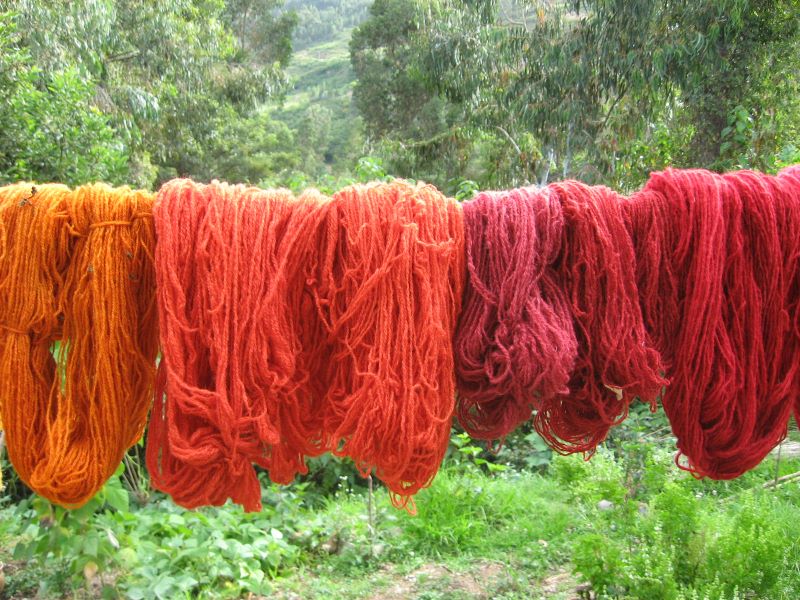Cochineal is magical as anyone who has watched a dye pot instantaneously transform in hue and color intensity will attest. Cochineal’s history is epic. The tale of the discovery of cochineal dye in the New World as told by Amy Butler Greenfield in, “A Perfect Red”, is a page turner.
Cochineal is a small bug that inhabits the prickly pear cactus (Opuntia). The female of the species contains carminic acid the source of the red dye. The cultivation of cochineal requires seeding a stand of prickly pear cactus, harvesting, drying, and grinding it into a fine dark red powder. The lifespan of cochineal is 70 to 90 days.
Fifteen years ago, PAZA contracted weavers of the Asociación de Artesanos Andinos (AAA) weaving cooperative to teach the first natural dye workshop in Huancarani. They presented cochineal and ever since it’s been the most frequently used natural dye. Since 2008, PAZA has purchased 11 kilos (24-1/4 lbs.). There’s been a growing sense of urgency to source cochineal as PAZA´s inventory has steadily decreased and is below a kilo. Doña Maxima called all contact numbers for PAZA´s former cochineal suppliers, but none could find any for sale.
For lack of a cochineal purveyor, Doña Maxima and Dorinda began brainstorming other sourcing possibilities. Peru produces and exports 80 – 95% of the world´s cochineal (percentage varies in studies posted online). A trip to purchase Peruvian cochineal would be nonsensical when cochineal proliferates on the prickly pear cactus growing throughout the State of Cochabamba.

Doña Maxima´s Cochabamba city-based son, Elmer, was aware of the quest and stopped along the road outside of the city and collected a few hundred grams. Doña Maxima has it drying and will test it in a dye pot during a Club de Artesanas club day.
Through the years, Doña Maxima has mentioned a cochineal development project on the Ayopaya River below Huancarani, but she couldn´t recall any details. A few days ago, Dorinda Googled cochineal cultivation in Bolivia. The first result was a PhD thesis by A. Tekelenburg published by Wageningen University and Research. www.edepot-wur.nl-139428
He was the Director of the Cactus Pear and Cochineal Research Project (PITC) in 1991 – 1992 that included Huancarani. Using the information to query Doña Maxima closer she remembered that her father and brothers had been involved in the project because her father had land along the river. Thinking back, as she would have been 10 in 1991, she remembered the prickly pear (Opuntia) cactus pads (nopales) arriving by truck to the soccer field that is the center of the community. She said horses probably carried the nopales down to the river a steep +2,000’ descent. She paused to ponder on how the horses were loaded considering their spiny cargo.
Dr. Tekelenburg’s thesis stated that there were 25 prickly pears already growing within the project area. The cactus can be propagated by rooting the nopales. Doña Maxima recalled that the newly planted cactus grew for one year and then dried out and died. She is going to ask her eldest brother, Don Octavio, who tends the fruit trees he has since planted on that land for his recollection of that cochineal project.
It will be up to the weavers to determine if another attempt should be made to cultivate cochineal. The objective of the early 90’s development project was to introduce a cash crop at a time that the market value was $100/kilo. The value dropped to $17/kilo in the 90’s, which is what PAZA paid to purchase 5 kilos in 2010. Angelica, who is a recent member of the Centro de Artesanía, Huancarani (CAH), collected cochineal and sold it to PAZA twice when she was in her early teens. At the time, PAZA, was well stocked and not in the market, but didn´t hesitate to purchase the wet red mess the destitute chica held out in her hands. Doña Toribia recently purchased alum and citric acid from Doña Maxima because her son had harvested cochineal in the area.
If the weavers chose not to pursue local cultivation, another option would be to seek partnerships with landowners close to the city. The landowners would probably negotiate good terms to have the cochineal removed from their prickly pear cactus stands. The cactus was historically and continues to be farmed for its flavorful fruit (tuna). Female cochineal live off the juice of the cactus which decreases the quality of the fruit. The cochineal introduced by development projects beginning in the late 80’s has spread. Landowners consider it a pest while natural dyers look out the bus window on the ride between Cochabamba and Independencia in frustration at the inaccessible white patches on the vast expanses of prickly pear.






wow, great reading. thanks
I hope you can get a project going. It has seemed to me for decades that given that the worldwide demand for cochineal is greater than the available supply, someone should be jumping on the opportunity. Good luck.
Deborah Chandler Guate cell with WhatsApp – 502-5308-0234 US phone rings in Guate – 970-449-9823 WARP Blog https://weavearealpeace.org/blog/ My Blog https://weavingfutureswithdc.wordpress.com/2020/05/30/waiting-for-the-unknown-esperando-el-gran-desconocido/ Ben Franklin Award winning books you might like Traditional Weavers of Guatemala – Their Stories, Their Lives A Textile Traveler’s Guide to Guatemala Rug Money – How a Group of Maya Women Changed Their Lives through Art and Innovation
I’m curious to see what path the weavers take in acquiring cochineal. Perhaps, they will achieve the objective of the 1991-91 development project and cultivate the cochineal as a cash crop. The pieces of this puzzle have been a long time in coming together because questions have to be properly phrased to receive an answer leading to the next appropriate question. Finding that thesis was like hitting the jackpot. I’m looking forward to many cochineal related conversations when I visit at year’s end – and hopefully will witness a burgeoning plan of action.